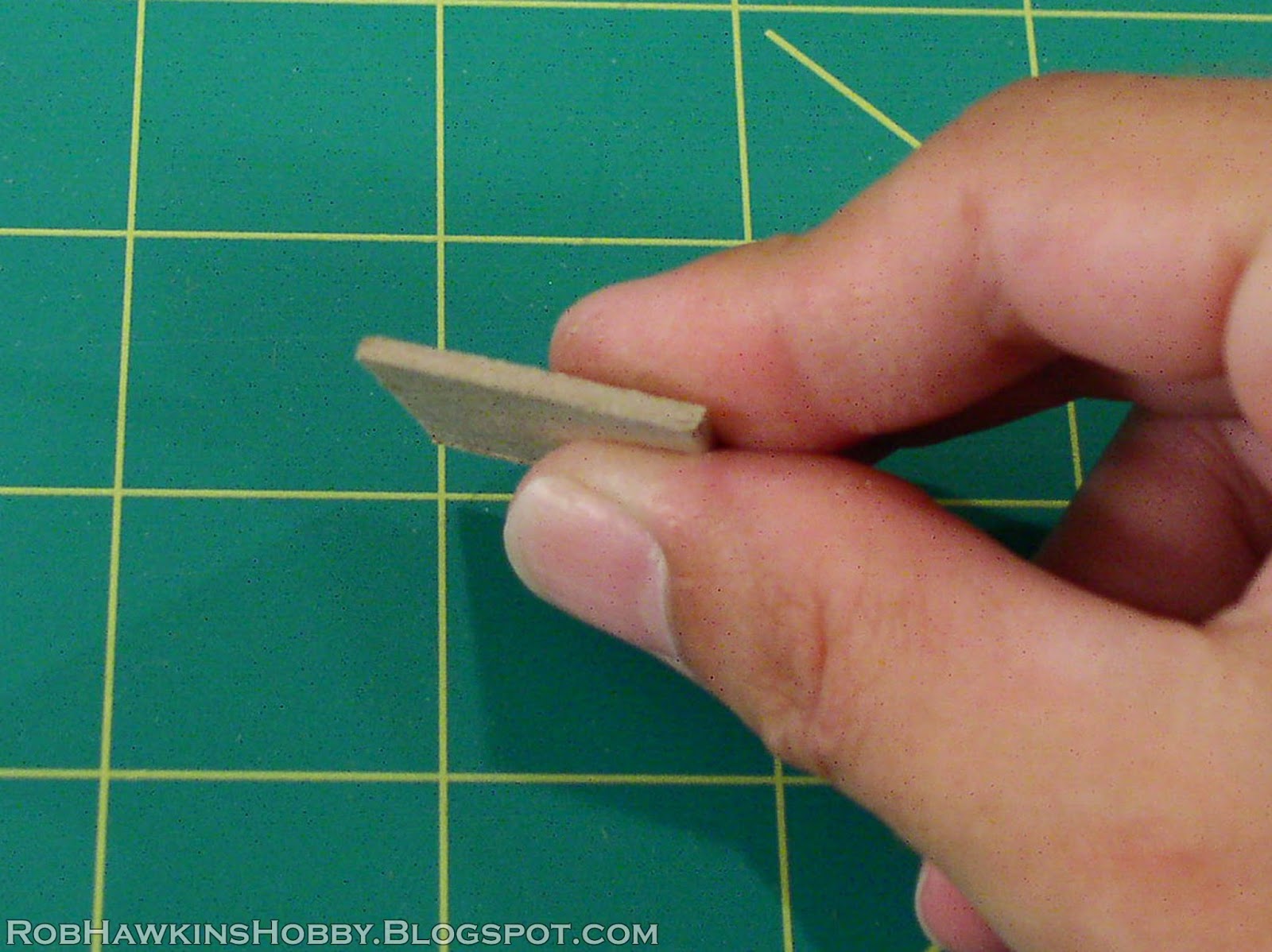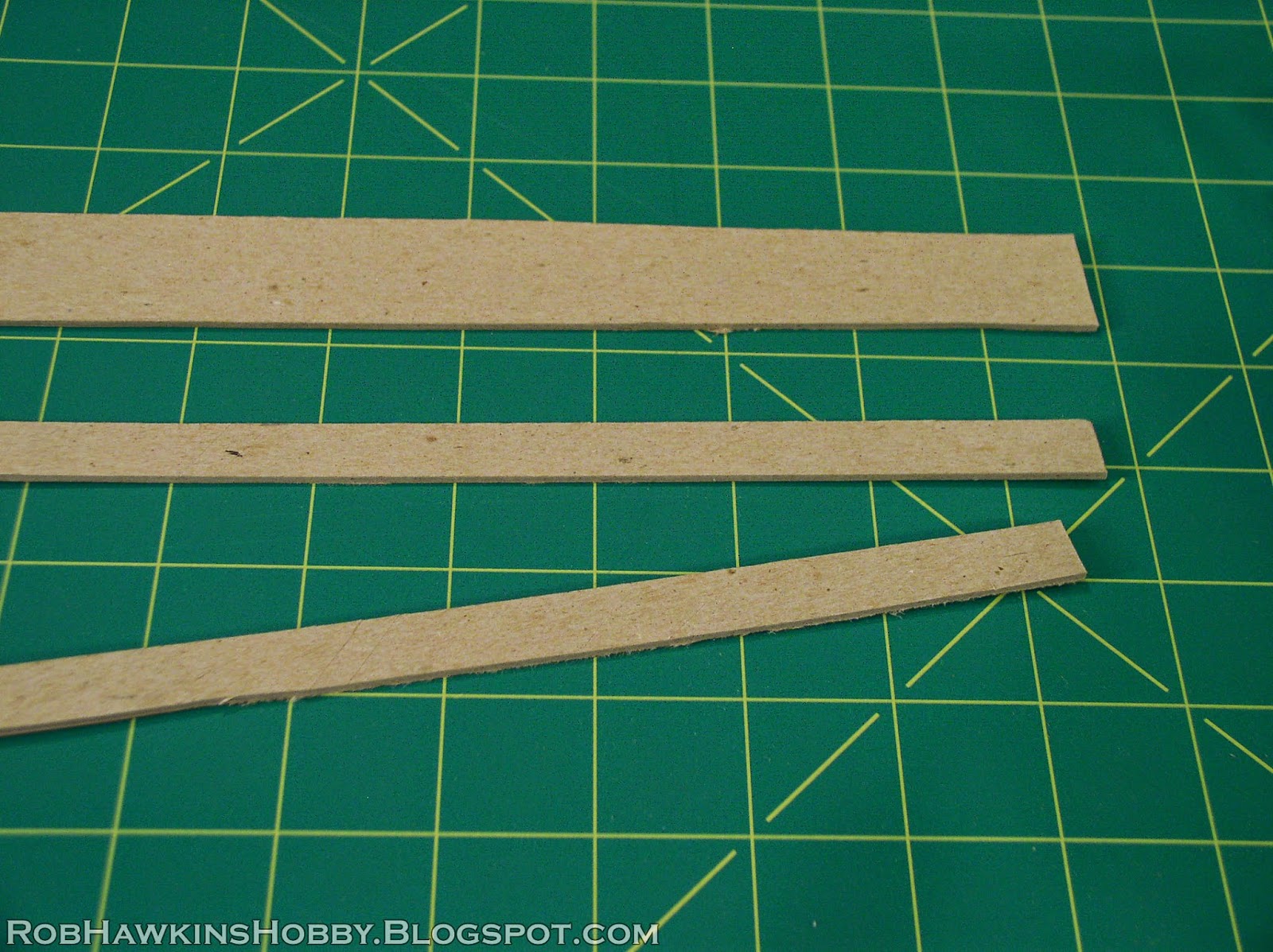Terrain Tutorial: Flagstone Streets
One of the techniques that I use in my projects is tiled flagstone streets. Different from cobblestone, this represents a surfaces of square-cut flagstone, sandstone, or slate. In this tutorial I'll show you how to make square stones, but this technique can also be used to apply irregularly-cut stones as well.

What you will need:
Thick cardboard
Steel ruler
Hobby knife, or snap-off extendable knife
Scissors
Hand sander
Vacuum
Hair dryer
Waterproof wood glue
Fine ballast
For the cardboard, you want something thick, but not so heavy that it can't be cut with scissors. Thin "cereal box" cardboard and two-ply art board really aren't thick enough. And corrugated cardboard is right out. The best material I've found is the thick cardboard on the back of drawing pads, legal pads, and such. Thicker card resists curling and provides the most depth to apply ballast in the gaps between stones.

Begin by cutting the cardboard into long strips. Unless you're creating a design that needs to be very precise, you don't need to do any measuring. Use the steel ruler and knife to cut the strips, and try to get a variety of widths.

Next, use scissors to cut the strips into little chits. Again, don't worry about measuring; you want a mix of square and rectangular (even trapezoidal) sizes.

Once you have amassed a nice pile of stones it's time to get to work laying them onto the board.

When laying in the stones, pay attention to the lines between the stones. Avoid creating continuous lines and positioning the stones four of them create "plus signs" or crosses. In this image, you can see how the layout on the left creates an irregular pattern. The straight lines are broken up and the intersections are Ts. The layout on the right is rife with continuous lines and many of the intersections look like a + symbol.
Having said that, when working on a large area, continuous lines and plus signs are inevitable. It's just something you should try to minimize as much as possible.

While you are laying in the stones, you will need to make a couple custom cuts to fit any odd gaps and angles that occur. Simply cut a larger stone in half, or have a spare strip of card on hand for making gap fillers.

Use wood glue to apply the stones. Spread a thin patch of glue on the table and press the stones into it. The glue coating should be thin enough that it doesn't squish out too much from underneath. The last thing you want is the spaces between each stone filled up with glue. To minimize the curling, I dip each stone in a cup of water before pressing it in place. Leave a slight gap between each stone (no more than 1/16 inch). Once all the stones are in place, let the piece dry overnight.

Some of the stones will curl while drying. To remove the curl, run a hand sander with a fine grit over the entire area. Take care not to knock off any stones as you work.
Wear a dust mask and eye protection and follow all the safety precautions whenever working with a sander.

The sanding also gives the stones a smooth edge, as though they are worn from years of weather and foot traffic. Vacuum the dust out of the crevices.

This next step requires a bit of patience and timing. Work on and finish one small portion of the board and then move on rather than trying to cover the entire surface in one go.
Mix up a batch of wood glue, thinned with water. Paint it over the surface, making sure it penetrates into all of the gaps between the stones.

Use a paper towel to wipe the glue off of the surface of the stones, leaving it in the crevices. Then, use a hair dryer with a cold setting to blow-dry the surface. Keep your distance so you don't blast the glue out of the cracks. You just want to dry the tops of the stones and leave the glue wet in the recesses. When it looks like the "shine" of wet glue is gone from the tops, you can add the ballast.

Use fine ballast and sprinkle it over the surface. If you've dried the tops properly, the ballast should fill in the recesses without sticking to the tops of the stones. Use your hand to gently brush the ballast around and make sure it's in the recesses, but take care not to smear any wet glue across the tops of the stones. Let this dry for about 15 to 20 minutes.

Once the glue has dried enough, use a vacuum to remove the excess ballast. Brush your hand over the surface to remove any ballast that may have stuck to the top, and take care not to suck the sand out of the gaps.

Now you've got the flagstones with sanded spaces between. If you are using this technique to create a small section of street or a patio, you should be able to finish the entire area in one pass, but for larger projects, take one area to this step and then move on to another area until you've finished the entire board.


To paint the board, drybrush and wash the stones with whatever colors you like (I've gone with a blue-grey slate color). Then use a fine brush to paint a thin wash of ink into the recesses. Once the ink dries, give the entire surface a final drybrush of P3 Menoth White Base or GW Screaming Skull to highlight the edges of the stones and the sand.

Here are some examples of the flagstones in my other projects with a variety of colors. You can leave a few spots without stones to create ruins or a street in a state of disrepair.



'Til next time!



















